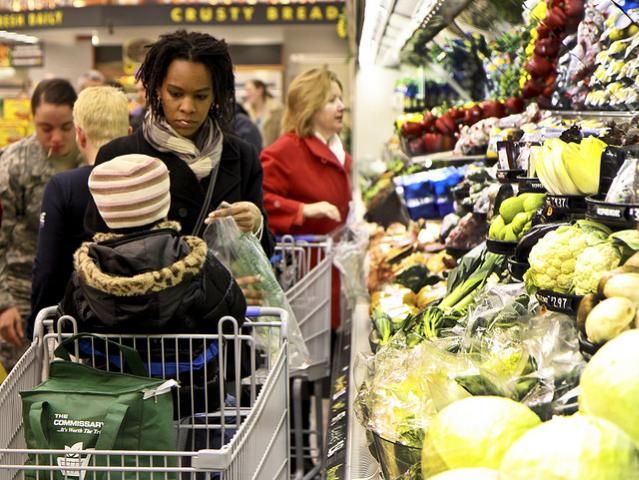Vegetables contain important vitamins, minerals, antioxidants, and fiber. These nutrients help to promote overall good health. It is recommended that Americans consume at least 2 to 3 cups of vegetables per day, but most Americans eat far fewer (USDHHS and USDA 2020).
Choosing vegetables will help you get the nutrients your body needs every day. It is recommended that we eat a variety of vegetables, especially dark-green, red, and orange vegetables, and dried beans and peas (USDHHS and USDA 2020). With so many choices though, vegetable shopping can seem like a hard task—but it doesn’t have to be. This article will help you learn to become a smarter vegetable shopper.
Shopping Tips
Here is a list of tips that will make vegetable shopping easy and fun.
Tip #1
Choose vegetables you know you like and know how to prepare. This is the easiest way to add vegetables to your diet.
Tip #2
Buy vegetables that are in season; they tend to be less expensive and have the best flavor. Table 1 shows a few common vegetables and when they are most likely to be in season. Search the Sustainable Table website at https://www.seasonalfoodguide.org to find seasonal vegetables.

Credit: Baloncici/iStock/Getty Images Plus
Tip #3
Buy pre-packaged, fresh vegetables that are already washed and sliced. These vegetables don’t need any work. They can be added directly to any recipe or eaten as a quick snack. The downside to these vegetables is that they tend to cost more.
Tip #4
Canned and frozen vegetables may cost less and have a longer shelf life than fresh vegetables. Canned vegetables can be high in sodium (salt), so choose cans labeled “low-sodium” or “no salt added” if available. You can also decrease the sodium content of canned vegetables by draining and rinsing them with water (Duyff et al 2011).
The benefits of canned and frozen vegetables include the following:
- Most canned and frozen vegetables are packaged within hours of being picked. This means the vegetables keep their flavor and nutrients.
- Canned vegetables are ready to use in recipes.
- Frozen vegetables require a short cooking time.
Tip #5
Add color to your vegetable choices. Eating vegetables with different colors gives your body a good mix of nutrients. The vegetables with the brightest colors often have the most vitamins (USDHHS and USDA 2020). For example, bright orange and yellow vegetables like sweet potatoes, carrots, and butternut squash are high in vitamin A.
Tip #6
If you have children or grandchildren, let them help with vegetable shopping. Letting them pick their own vegetables makes the shopping trip fun and educational. Children are more likely to eat the vegetables they choose (USDA ChooseMyPlate.gov n.d.).

Credit: Carol E. Davis, Creative Commons license CC BY 2.0, US Army Corps of Engineers
Farmers' Markets
Farmers' markets may be a great place to buy fresh vegetables. They often provide shoppers with farm-fresh, locally grown vegetables that are in season. Farmers' markets allow shoppers to know where their food comes from. You may even get a chance to meet the farmer who grew the produce. However, there is no guarantee that vegetables sold at a Farmers' market are freshly picked, local produce. Ask about the source and always check the quality of the produce before purchasing.
Many farmers' markets are now taking part in nutrition assistance programs. These programs include the Supplemental Nutrition Assistance Program (SNAP) (USDA FNS – SNAP n.d.), the Women, Infants, and Children (WIC) Farmers' Market Nutrition Program (USDA FNS – FMNP n.d.), as well as the Senior Farmers' Market Nutrition Program (SFMNP) (USDA FNS – SFMNP n.d.).
To find a farmers' market near you, visit https://www.usdalocalfoodportal.com/fe/fdirectory_farmersmarket/. In Florida, you can also visit Florida MarketMaker online at http://fl.marketmaker.uiuc.edu/. Florida MarketMaker is a FREE resource and service of the Florida Cooperative Extension Service that allows consumers to visualize the marketplace and connect with producers, retailers, restaurants, and farmers' markets with a search-and-map feature.
Organic Vegetables
Many people wonder what the term "organic" means and if organic foods are healthier choices. The farmers who grow organic vegetables do so without the use of standard pesticides. Vegetables labeled with the organic seal must be grown on a farm that has passed a government inspection (USDA AMS – National Organic Program n.d.).
Are organic vegetables the healthier choice? The U.S. Department of Agriculture (USDA) states that regular vegetables are just as nutritious as organic vegetables (USDA AMS – National Organic Program n.d.). The term "organic" only refers to the way the vegetables are grown, handled, and processed. Even though there may be no nutritional difference, there can be a difference in cost. Organic vegetables may cost more than regular vegetables.
Whether you choose to eat organic or non-organic vegetables, the most important point is to eat more vegetables and to always follow basic food safety recommendations. For more information on this topic, refer to the EDIS publication, Fresh Produce: Safe Handling Practices for Consumers (FCS8737), available at https://edis.ifas.ufl.edu/publication/FY481.
Where can I get more information?
Your local UF/IFAS Extension Family and Consumer Sciences (FCS) agent may have more written information and nutrition classes for you to attend. Also, a registered dietitian/nutritionist (RDN) can provide you with reliable information. Reliable nutrition information may be found at the following sites:
References
Duyff RL, Mount JR, Jones JB. Sodium reduction in canned beans after draining, rinsing. Journal of Culinary Science & Technology. 2011 Apr 1;9(2):106-12.
USDA AMS National Organic Program. n.d. https://www.ams.usda.gov/about-ams/programs-offices/national-organic-program
USDA Choosemyplate.gov. n.d. https://www.myplate.gov/eat-healthy/vegetables
USDA FNS – Supplemental Nutrition Assistance Program (SNAP). n.d. https://www.fns.usda.gov/snap/supplemental-nutrition-assistance-program
USDA FNS – WIC Farmers' Market Nutrition Program (FMNP). n.d. https://www.fns.usda.gov/fmnp/wic-farmers-market-nutrition-program
USDA FNS – Senior Farmers' Market Nutrition Program. n.d. https://www.fns.usda.gov/sfmnp/senior-farmers-market-nutrition-program
USDA and USDHHS. 2020. "Dietary Guidelines for Americans 2020-2025." Available at: https://www.dietaryguidelines.gov/resources/2020-2025-dietary-guidelines-online-materials